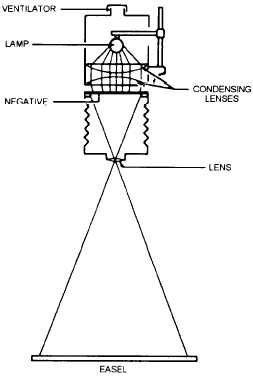enlarged the same size as the negative image or reduced
in size. When the print images are larger than the
negative images, the process is called enlarging. When
the print images are smaller than the negative images,
the process is called reducing. Because projection
printing is usually used to make positive prints with
images larger than the negative, projection printers are
referred to as enlargers. The term enlarging generally
refers to all forms of projection printing.
Projection printing differs from contact printing
because the negative is separated from the paper, and
the image is projected by a lens onto the sensitized
material The negative is placed between an enclosed
light source and a lens. The lens receives the light that
passed through the negative and projects the image onto
the paper. Changing the distance between the lens and
the paper controls the size of the image. The image is
focused on the paper by adjusting the distance between
the negative and the lens. You can enlarge or reduce the
size of the projected image by changing and adjusting
these distances.
Enlarging is a very adaptable and versatile process,
because considerable image and exposure control can
be used. The main advantage of enlarging over contact
printing is large prints can be made, but there are several
other important advantages. The advantages of
projection printing are as follows:
Cropping or selecting the main area of interest in
a negative can be enlarged to any suitable size. This
provides an opportunity for you to eliminate unwanted
and distracting elements from around the point of
interest of the picture.
Dodging or burning in. This allows you to apply
local exposure control to bring out more detail in the
highlight and shadow areas.
Local fogging with a small external light, such as
a penlight, to darken selected areas; for example, by
darkening the background of a portrait, you direct the
viewer’s attention to the face.
Special effects can be performed, such as
changing the appearance of the image by use of diffusers
or patterns between the lens and paper.
Image distortion correction or introduction can
be done by tilting the enlarger easel. (An easel is the
device used to hold the paper during exposure.)
Figure 11-7.–Basic enlarger.
ENLARGERS
In general, all enlargers are similar in design and
operation. They have an enclosed light source, some
method of providing an even distribution of light over
the negative, a negative carrier, a lens, a means of
adjusting the lens-to-negative and lens-to-paper
distances (fig. 11-7). The degree to which the image is
enlarged can be referred to in terms of diameters; for
example, a two diameter or 2X enlargement is twice the
length and twice the width of the negative image, or four
times the area A three diameter or 3X enlargement is
three times the length and width of the negative image,
or nine times the area.
Most enlargers have a tungsten lamp as a light
source. The lamp is enclosed in a lighttight housing that
is ventilated to prevent excessive lamp heat from
damaging the negative. Some enlargers have blowers to
circulate air and cool the inside of the lamp housing.
The negative carrier used in an enlarger may be
either a dustless type or a glass sandwich type. The
dustless type of carrier is made of two metal plates with
an opening in the center large enough to hold the
negative. The negative is placed between these plates
and held in position by its edges. This type of carrier is
good for negatives 4x5 or smaller, since these negatives
are stiff enough to remain flat. The glass sandwich type
11-9


